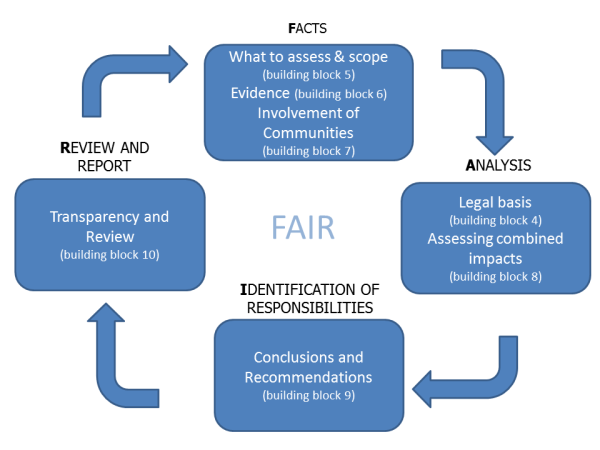The FAIR approach - putting a human rights based approach into practice
The Scottish Human Rights Commission has developed the 'FAIR' approach to help you apply the standards and principles of human rights in practice. The basic steps of the FAIR approach are:
-
Facts: What is the experience of those involved and what are the important facts to understand?
-
Analyse rights: Develop an analysis of the human rights at stake
-
Identify responsibilities: Identify what needs to be done and who is responsible for doing it
-
Review actions: Make recommendations for action and later recall and evaluate what has happened as a result.
This FAIR approach can be applied in a number of ways. Firstly, it can be seen to reflect the overall process of good practice impact assessment. See the diagram and table below which maps FAIR against the Good Practice Building Blocks of impact assessment:

|
Steps of FAIR |
Good Practice Impact Assessment Building Blocks |
|---|---|
|
What is the experience of those involved? Are they being heard and if not, do they require support to do so? What are the important facts to understand? |
What to assess & scope (building block 5) Evidence (building block 6) Involvement of Communities (building block 7) |
|
Analysis of right(s) at stake What are the human rights or issues at stake? Is the right to life or the right not to be subjected to inhuman or degrading treatment at stake? If so, these rights are absolute and cannot be restricted. Can the right be restricted? What is the justification for restricting the right? Is the restriction on the right 'proportionate'? i.e. is it the minimum necessary restriction to meet the aim or is a "sledgehammer being used to crack a nut"? |
Legal basis (building block 4) Assessing combined impacts (building block 8) |
|
Identification of shared responsibilities What changes are necessary? Who has responsibilities for helping to make the necessary changes? |
Conclusions and Recommendations (building block 9) |
|
Review Actions Have the actions taken been recorded and reviewed and has the individual affected been involved? |
Transparency and Review (building block 10) |
FAIR can also be applied as a framework to assist in thinking through and discussing equality and human rights issues at stake. This should be done with the full participation of affected rights holders.
The FAIR framework has been used to analyse the case studies.


